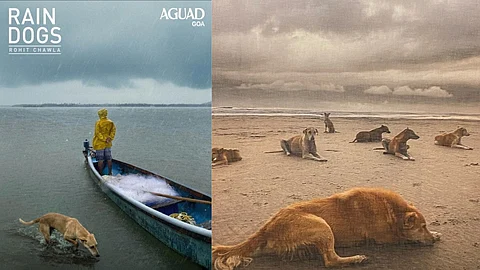
- HOMEGROWN WORLD
- #HGCREATORS
- #HGEXPLORE
- #HGVOICES
- #HGSHOP
- CAREERS
- ABOUT US
- CONTACT US

All it takes is one pack of biscuits to earn a dog’s loyalty for life. Stray dogs, our shared companions in neighborhoods and public spaces, define community as they're collectively cared for by everyone. But what happens when the world suddenly shuts down, and everyone is confined behind closed doors? During the pandemic, as humans scrambled to adapt to a new reality, stray dogs were left to fend for themselves. The streets and beaches emptied out, tourists vanished, and the leftover feasts they depended on disappeared. These loyal, ever-present companions found themselves abandoned, hungry, and forgotten.
For photographer Rohit Chawla, the lockdown was not just a period of isolation but an testing chapter in his life. Known for his striking portraits and evocative storytelling, Rohit was used to a life of travel and human interaction. Stripped of that rhythm, he found himself retreating to Goa, seeking solace under its monsoon skies. Amidst the desolation, it was the stray dogs of Ashwem beach that gave him a sense of purpose, and comforted him as he grappled with the death of a loved one.
Walking 20 kilometers daily along the deserted shoreline, Rohit was followed by a pack of hopeful strays. These dogs, emaciated and desperate, clung to him, not just for food but perhaps for the shared understanding of loss. “It broke my heart to see their eyes — large, hollow, and dead with hunger,” he recalls. And so, he began photographing them, not to turn their plight into art, but to find a way to process his own vulnerability and helplessness.
These photographs, now compiled in the book, 'Rain Dogs', are unlike anything he’s ever done. The quiet, introspective images reflect the stark bleakness of those times. Against the dramatic backdrop of the Goan monsoon's stormy skies, endless waves, and shimmering rain, its agonists protbecome poignant figures of survival. Through his lens, Rohit captured not just the dogs but the fragile bond they shared with him. "They reminded me that love is a simple thing that's lost to us at times on account of too much reflection, too much analysis of our lives, and too much questioning as to where our lives are going," he shares.
Over three years, Rohit clicked over 10,000 photographs, distilling the essence of his experience into about 100 images for an exhibition and the book. The series, both haunting and hopeful, reveals a story that is deeply political yet profoundly personal. It’s a reflection of a world left unmoored and the resilience of creatures who continue to endure despite being overlooked. The photographer's work also challenges perceptions about India’s indie dogs. With over 70,000 stray dogs on Goa’s beaches alone, these animals are often marginalised, yet they play an integral role in the fabric of our communities. Rain Dogs is as much a tribute to them as it is a call for compassion.
Rohit's time with these 'rain dogs' is a story of survival, love, and the ability to be there for each other — something that sustains us in the darkest of times. It show us something we often forget: that we’re all just looking for a little kindness and a little hope. Perhaps, when we show up for others, whether they walk on two legs or four, we end up saving a piece of ourselves too.
The Rain Dogs exhibition is on display at Aguad, Goa until February 15.
Follow Rohit here.
